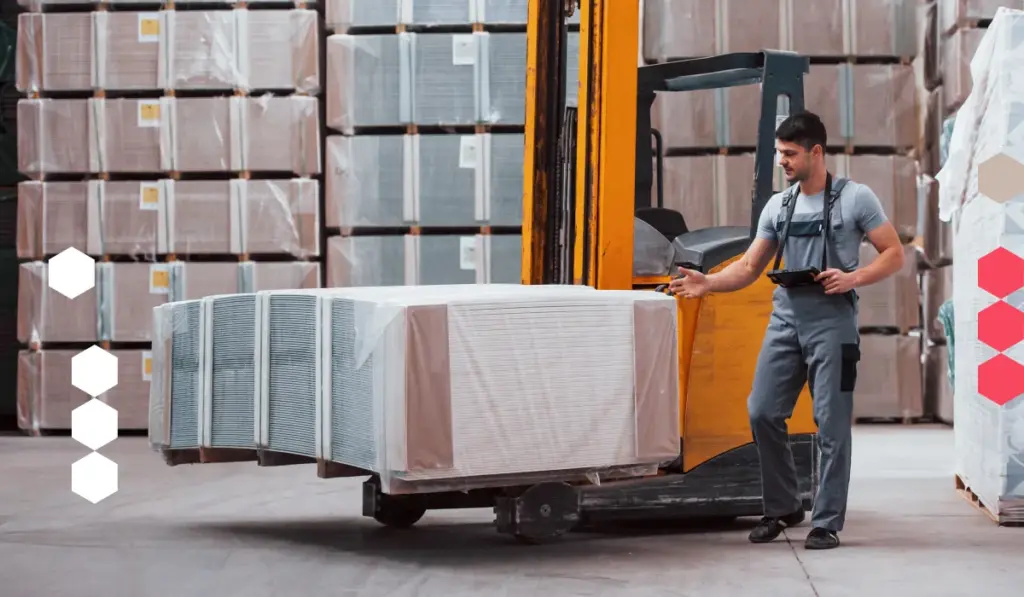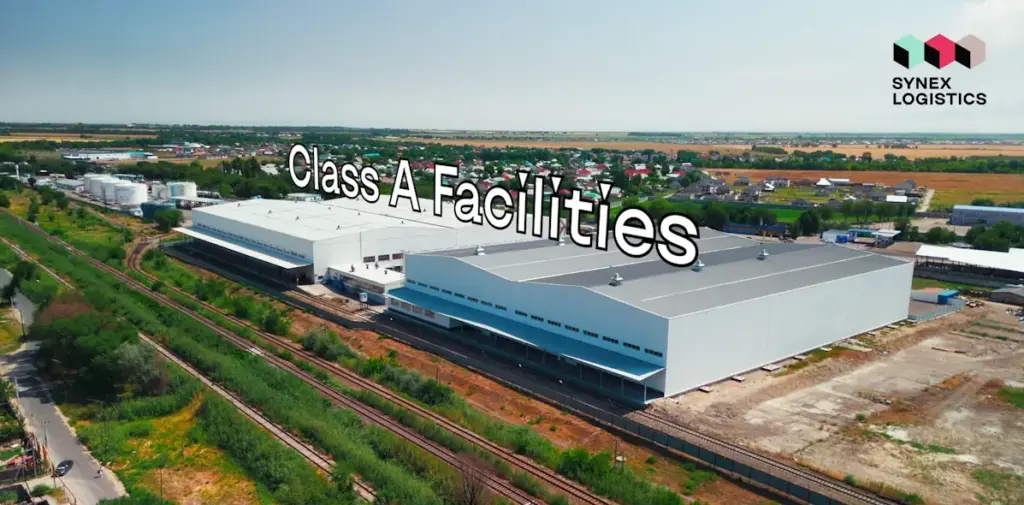Warehouse Classification and Purpose in Logistics

Efficient inventory management and secure storage are essential for seamless logistics operations and sustainable business performance. Warehouse classification provides a clear framework for identifying suitable facilities based on product type and a company’s operational needs. This article explores key warehouse classes, their characteristics, and how they differ by function and storage conditions — offering valuable insights for logistics professionals, procurement managers, and business owners seeking to optimize warehouse processes and supply chains.
Table of Contents:
- Warehouse Classification (A, B, C, D)
- Types of Warehouses by Function
- Types of Warehouses by Storage Conditions
- SYNEX Logistics – Warehouse Logistics Experts
- Conclusion
Warehouse Classification (A, B, C, D)
In logistics, warehouses are assessed using a standardized international grading system based on infrastructure, technical features, and level of automation. This classification helps businesses select facilities suited to their product requirements and operational goals — ranging from premium A+ logistics hubs to cost-efficient D-class storage sites.
Class A+ Warehouses
Class A+ warehouses are purpose-built logistics facilities that meet the highest international standards. They are ideal for storing high-value, sensitive products such as electronics, pharmaceuticals, cosmetics, and medical equipment. These sites are typically used in high-intensity operations where precise temperature control and uninterrupted workflows are mission-critical.
Key features:
- Single-story building with column-free design or with column spacing from 12 to 24 meters
- Ceiling height: 13 meters
- Reinforced concrete flooring (≥5 t/m²) with anti-dust coating
- At least 1 dock door per 500 m²
- Ventilation, air conditioning, and climate control systems
- Automated fire suppression system
- High-speed internet and monitoring systems
- 24/7 security coverage
- Comfortable office spaces, access roads, and on-site parking
Class A Warehouse
High-quality, modern facilities suitable for distribution, retail, and e-commerce, often operating as full-service distribution centers. They are a more economical option compared to Class A+ warehouses, with only minor differences in specifications:
- Ceiling height: from 10 meters
- Column spacing: from 9 meters
- Dock doors: at least 1 per 1,000 m²
- Flooring: concrete with anti-dust coating, without the additional reinforcement typical of Class A+
- Safety and climate control systems may vary in automation level or scale
- IT infrastructure: equipped with basic systems
- Option to connect a private transformer substation or heat generator
Class B Warehouse
Reliable and cost-effective facilities designed for the storage of medium-weight goods, offering potential for reduced operating costs. Class B warehouses are functional buildings that have been reconstructed or repurposed for storage needs. They are typically one or two stories, with a freight elevator of up to 3 tons if a second floor is present. Standard features include heating, fire alarm systems, loading ramps, and maneuvering areas for trucks, although the level of automation is limited. Security is ensured through gated premises, alarm systems, and video surveillance.
Class C Warehouse
Class C warehouses are converted former production buildings or hangars, typically with ceiling heights starting at 4 meters and concrete or asphalt floors. Reliable and cost-effective facilities designed for the storage of medium-weight goods, offering potential for reduced operating costs. A budget-friendly option, these facilities offer minimal infrastructure and basic security measures.
Class D Warehouse
Class D facilities are adapted from spaces not originally intended for logistics use—such as basements, workshops, or outdated hangars—without essential warehouse infrastructure. They are intended for storing low-value, immobile, or non-sensitive-to-environment goods. Typically, these premises lack heating, ventilation, and security systems. Storage is handled manually, with minimal automation and virtually no requirements for layout or equipment.
Types of Warehouses by Function
Warehouses differ not only by class but also by their intended purpose, which directly affects their location, logistics setup, and required infrastructure.
Production Warehouses
Located on-site or near manufacturing plants, these facilities ensure production continuity by reducing transport time and cost and enabling just-in-time inventory flow. They store raw materials, components, semi-finished goods, and finished items intended for the next production stage. With high turnover rates, they support real-time production needs while minimizing excess inventory.
Transit Warehouses
Designed for short-term storage of in-transit cargo on the way from shipper to consignee. Serving as an intermediate logistics node, they enable route optimization, cross-docking, batch consolidation/splitting, and rapid transloading/intermodal transfers—especially during peak seasons, when speed and efficiency are critical. Dwell times are minimal (from several hours to a few days), with high-speed processing and sorting. Optimal siting is at transportation hubs and junctions to ensure routing efficiency and end-to-end operational responsiveness.

Wholesale Warehouses
These facilities store large-volume goods before dispatch to distributors, wholesale buyers, and retail chains. They are characterized by expansive floor space, high load-bearing capacity, and well-structured storage systems organized by category, SKU, lot, expiry date, and other parameters. Equipped with advanced warehouse management systems (WMS) and Internet of Things (IoT)-based solutions; they enable real-time inventory tracking, monitoring, and environmental control. A wholesale warehouse may serve a single manufacturer or operate as part of a logistics hub, consolidating products from multiple suppliers.
Retail Warehouses
Located close to or within stores, these facilities support rapid shelf replenishment and e-commerce order fulfillment, shortening delivery times to the end customer. Though smaller than wholesale sites, they prioritize high-speed picking and dispatch, with fast-dispatch zones and flexible/extended operating hours. With the rise of e-commerce, many operate as dark stores dedicated to online orders.
Temporary Customs Warehouses
Used for storing goods pending customs clearance in import/export flows. Goods are kept under strict control for up to 90 days (jurisdiction-dependent). These facilities are critical on high-trade corridors e.g., China–Kazakhstan, ensuring secure storage, sealed areas, access control/logs, and reporting to customs authorities in line with regulations. Proximity to border checkpoints, ports, or logistics terminals is essential.
Types of Warehouses by Storage Conditions
For effective storage of different products, it is important to consider not only the warehouse’s purpose but also the environmental conditions in which goods are kept. Depending on temperature, humidity, and other factors, warehouses are classified into several types, each suitable for specific categories of cargo.
Non-Heated Warehouses
Basic facilities without heating or climate control, appropriate for goods resistant to temperature and humidity fluctuations, such as construction materials, tools, seasonal products, and packaging. These warehouses are widely used in logistics due to their low operating costs.
Climate-Controlled Warehouses
Maintain stable temperature and humidity year-round, regardless of the season. Essential for goods sensitive to environmental changes, such as electronics, pharmaceuticals, cosmetics, paper, and textiles. Often featuring advanced air filtration systems and dust control to protect stored items.
Refrigerated Warehouses
Operate at +2 to +8 °C, designed for short-term storage of perishable products, including food, flowers, beverages, and medicines. Uninterrupted operation of refrigeration equipment ensures the freshness and quality of stored goods.
Freezer Warehouses
Used for long-term storage at −18 °C or below. Freezer warehouses are intended for storing frozen food, seafood, semi-finished goods, and certain pharmaceuticals or biomaterials. Equipped with high-grade thermal insulation and emergency monitoring systems to prevent temperature deviations.
SYNEX Logistics – Warehouse Logistics Experts
At SYNEX Logistics, we handle the entire warehousing cycle—from inbound receipt and placement to order picking and dispatch. We operate under the contract logistics model, ensuring transparent, technology-driven service in compliance with FIFO and FEFO standards. Over 70% of our team has been working in warehouse logistics since 2009, with over 1,500 logistics professionals involved in daily operations.
For accurate inventory management, automation, and control, we use modern WMS systems—particularly important for e-commerce, retail, and distribution, where order-fulfillment speed plays a decisive role. Our warehouses feature CCTV, access control, and temperature monitoring systems, making them suitable for both standard and specialized cargo. All processes are built in accordance with international requirements, as confirmed by ISO9001:2015 certification.
If you are looking for reliable warehousing solutions, contact SYNEX Logistics —we will select the optimal format for your needs.
Conclusion
Understanding warehouse classification and purpose is fundamental to building efficient and resilient supply chains. Choosing the right warehouse type helps lower operating costs, accelerate delivery, and enhance both storage reliability and product integrity. Whether your business is in e-commerce, retail, manufacturing, or international trade, a well-informed approach to warehouse infrastructure becomes a strategic advantage in today’s competitive market.





